西方文化导论 复习版
- 格式:doc
- 大小:56.50 KB
- 文档页数:4
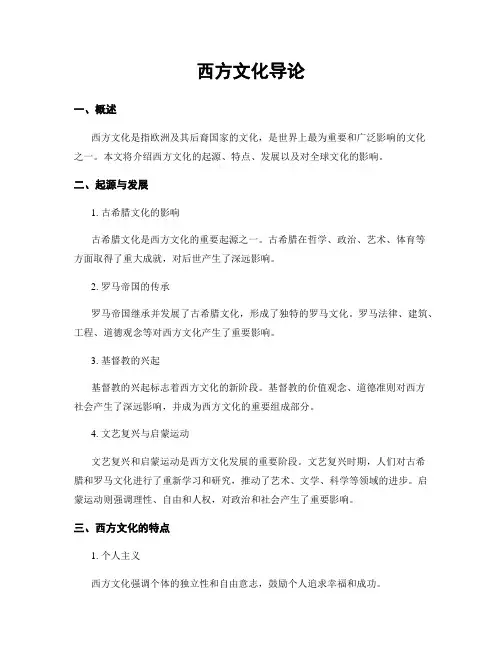
西方文化导论一、概述西方文化是指欧洲及其后裔国家的文化,是世界上最为重要和广泛影响的文化之一。
本文将介绍西方文化的起源、特点、发展以及对全球文化的影响。
二、起源与发展1. 古希腊文化的影响古希腊文化是西方文化的重要起源之一。
古希腊在哲学、政治、艺术、体育等方面取得了重大成就,对后世产生了深远影响。
2. 罗马帝国的传承罗马帝国继承并发展了古希腊文化,形成了独特的罗马文化。
罗马法律、建筑、工程、道德观念等对西方文化产生了重要影响。
3. 基督教的兴起基督教的兴起标志着西方文化的新阶段。
基督教的价值观念、道德准则对西方社会产生了深远影响,并成为西方文化的重要组成部分。
4. 文艺复兴与启蒙运动文艺复兴和启蒙运动是西方文化发展的重要阶段。
文艺复兴时期,人们对古希腊和罗马文化进行了重新学习和研究,推动了艺术、文学、科学等领域的进步。
启蒙运动则强调理性、自由和人权,对政治和社会产生了重要影响。
三、西方文化的特点1. 个人主义西方文化强调个体的独立性和自由意志,鼓励个人追求幸福和成功。
2. 科学与技术的重视西方文化崇尚科学与技术的发展,注重实证主义和理性思维,推动了现代科学的进步。
3. 民主与法治西方文化倡导民主政治和法治社会,注重个人权利和平等,推动了现代民主制度的发展。
4. 艺术与文学的创新西方文化在艺术与文学领域具有创新精神,不断探索新的表达形式和艺术风格。
四、西方文化对全球的影响1. 语言和文学英语作为西方文化的代表语言,成为国际交流和商务的重要工具。
西方文学作品如莎士比亚的戏剧、浪漫主义文学等对全球文学产生了深远影响。
2. 科学与技术西方文化的科学与技术成果对全球产生了广泛影响,如工业革命、电子技术、计算机科学等。
3. 政治与法律西方文化的民主制度和法治观念对全球政治和法律体系的发展产生了重要影响。
4. 艺术与娱乐西方音乐、电影、时尚等艺术与娱乐形式在全球范围内受到广泛欢迎,成为全球流行文化的一部分。
五、结论西方文化作为世界上最重要和广泛影响的文化之一,其起源、发展、特点以及对全球的影响都具有重要意义。
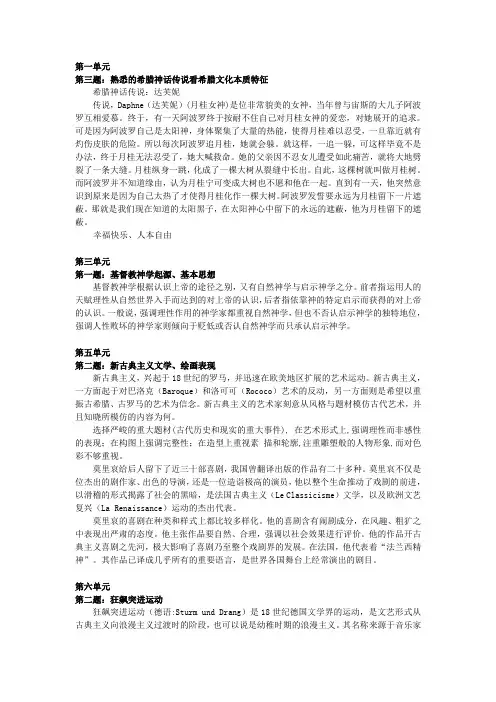
第一单元第三题:熟悉的希腊神话传说看希腊文化本质特征希腊神话传说:达芙妮传说,Daphne(达芙妮)(月桂女神)是位非常貌美的女神,当年曾与宙斯的大儿子阿波罗互相爱慕。
终于,有一天阿波罗终于按耐不住自己对月桂女神的爱恋,对她展开的追求。
可是因为阿波罗自己是太阳神,身体聚集了大量的热能,使得月桂难以忍受,一旦靠近就有灼伤皮肤的危险。
所以每次阿波罗追月桂,她就会躲。
就这样,一追一躲,可这样毕竟不是办法,终于月桂无法忍受了,她大喊救命。
她的父亲因不忍女儿遭受如此痛苦,就将大地劈裂了一条大缝。
月桂纵身一跳,化成了一棵大树从裂缝中长出。
自此,这棵树就叫做月桂树。
而阿波罗并不知道缘由,认为月桂宁可变成大树也不愿和他在一起。
直到有一天,他突然意识到原来是因为自己太热了才使得月桂化作一棵大树。
阿波罗发誓要永远为月桂留下一片遮蔽。
那就是我们现在知道的太阳黑子,在太阳神心中留下的永远的遮蔽,他为月桂留下的遮蔽。
幸福快乐、人本自由第三单元第一题:基督教神学起源、基本思想基督教神学根据认识上帝的途径之别,又有自然神学与启示神学之分。
前者指运用人的天赋理性从自然世界入手而达到的对上帝的认识,后者指依靠神的特定启示而获得的对上帝的认识。
一般说,强调理性作用的神学家都重视自然神学,但也不否认启示神学的独特地位,强调人性败坏的神学家则倾向于贬低或否认自然神学而只承认启示神学。
第五单元第二题:新古典主义文学、绘画表现新古典主义,兴起于18世纪的罗马,并迅速在欧美地区扩展的艺术运动。
新古典主义,一方面起于对巴洛克(Baroque)和洛可可(Rococo)艺术的反动,另一方面则是希望以重振古希腊、古罗马的艺术为信念。
新古典主义的艺术家刻意从风格与题材模仿古代艺术,并且知晓所模仿的内容为何。
选择严峻的重大题材(古代历史和现实的重大事件), 在艺术形式上,强调理性而非感性的表现;在构图上强调完整性;在造型上重视素描和轮廓,注重雕塑般的人物形象,而对色彩不够重视。
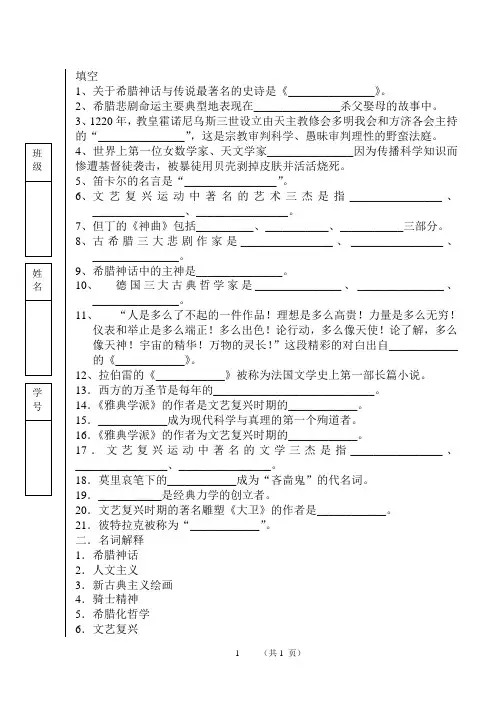
填空1、关于希腊神话与传说最著名的史诗是《_______________》。
2、希腊悲剧命运主要典型地表现在_______________杀父娶母的故事中。
3、1220年,教皇霍诺尼乌斯三世设立由天主教修会多明我会和方济各会主持的“_______________”,这是宗教审判科学、愚昧审判理性的野蛮法庭。
4、世界上第一位女数学家、天文学家_______________因为传播科学知识而惨遭基督徒袭击,被暴徒用贝壳剥掉皮肤并活活烧死。
5、笛卡尔的名言是“________________”。
6、文艺复兴运动中著名的艺术三杰是指________________、________________、________________。
7、但丁的《神曲》包括__________、___________、___________三部分。
8、古希腊三大悲剧作家是________________、________________、_______________。
9、希腊神话中的主神是_______________。
10、德国三大古典哲学家是_______________、_______________、_______________。
11、“人是多么了不起的一件作品!理想是多么高贵!力量是多么无穷!仪表和举止是多么端正!多么出色!论行动,多么像天使!论了解,多么像天神!宇宙的精华!万物的灵长!”这段精彩的对白出自____________的《____________》。
12、拉伯雷的《____________》被称为法国文学史上第一部长篇小说。
13.西方的万圣节是每年的____________________________。
14.《雅典学派》的作者是文艺复兴时期的____________。
15.____________成为现代科学与真理的第一个殉道者。
16.《雅典学派》的作者为文艺复兴时期的____________。

我西方文论选读复习资料1.柏拉图:古希腊哲学家,苏格拉底的学生。
公园前387年在雅典城外建立学园开始授徒讲学,撰写对话。
柏拉图的作品即《柏拉图文艺对话集》中讨论美学和文艺理论问题较多的有:《大希庇阿斯》、《伊安》、《高吉阿斯》、《会饮》、《斐德若》、《理想国》、《斐利布斯》、《法律》等。
▲柏拉图《伊安》和《斐若德》内容:主要阐述了"迷狂说"和"灵魂回忆说":柏拉图认为,高明的诗人都是凭灵感来创作,而灵感来自于两种途径,一是"神灵凭附",一是"灵魂回忆"。
当诗人获得了诗神的灵感或在灵魂中回忆到了理念世界,就可能产生一种精神上的迷狂状态。
诗神的作品就是在这样一种情感状态下创作出来的。
这在一定意义上否定了技艺和经验在文学创作中的作用。
▲柏拉图《理想国》阐述的问题(1)("模仿说"):文艺模仿现实事物,现实事物模仿理念,因而文艺与真理隔着两层,是模仿的模仿,影子的影子。
(2)文艺的这种属性,使得它无原则地同情和滋长了人的不良心理和原始情欲,颠覆了人的理性,成为一种低贱的东西。
这也正是柏拉图要在他所构想的理想国中驱逐诗人的理论依据。
2.亚里斯多德:古希腊哲学家、自然科学家、文艺理论家。
17岁到雅典,成为柏拉图高足。
公元前335年创办吕克昂学院。
现存著作47种,文艺理论著作只有《修辞学》《诗学》及对话《格律罗斯》论文《忒俄得克忒亚》。
▲亚里士多德《诗学》内容涉及诗的起源、分类、真实性、以及悲剧观念等问题。
(1)艺术模仿说:①亚里斯多德认为诗或艺术起源于人的模仿本能。
因模仿对象不同,而有悲剧和喜剧;因模仿方式不同,而有史诗、抒情诗和戏剧。
②艺术模仿是创造性的,模仿出来的是可能发生的事;艺术所模仿的对象是真实的,艺术体现的“可然律和必然律”,是一种富有哲学意味的高度真实性。
(2)亚里士多德对悲剧的认识与柏拉图不一致:悲剧,是一个严肃、完整、有一定长度的行动的模仿;其效果是引起观众的恐惧和怜悯,使人的心灵得到陶冶;悲剧成分(形象、性格、思想、情节、言词、歌曲)中,情节是最重要的,人物性格居第二位。
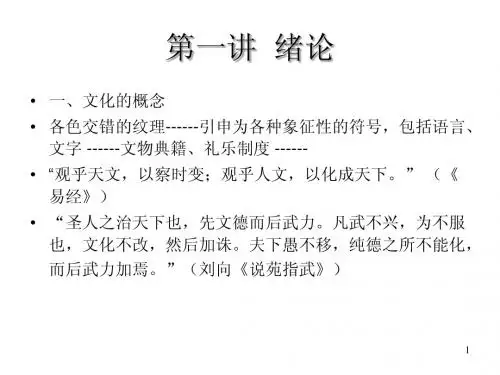
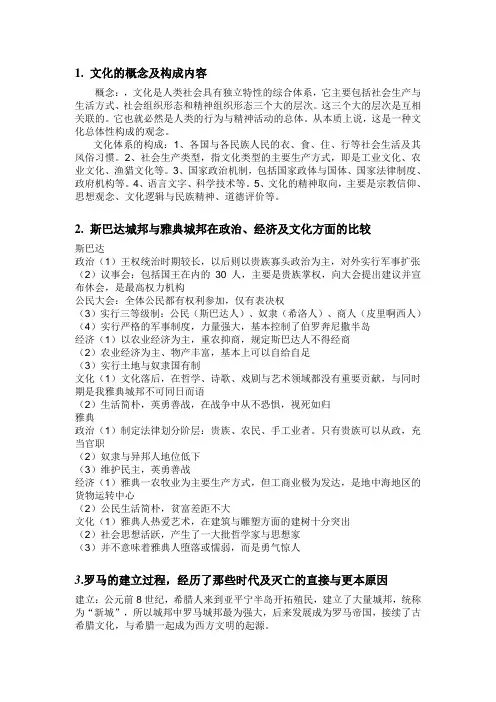
1.文化的概念及构成内容概念:,文化是人类社会具有独立特性的综合体系,它主要包括社会生产与生活方式、社会组织形态和精神组织形态三个大的层次。
这三个大的层次是互相关联的。
它也就必然是人类的行为与精神活动的总体。
从本质上说,这是一种文化总体性构成的观念。
文化体系的构成:1、各国与各民族人民的衣、食、住、行等社会生活及其风俗习惯。
2、社会生产类型,指文化类型的主要生产方式,即是工业文化、农业文化、渔猎文化等。
3、国家政治机制,包括国家政体与国体、国家法律制度、政府机构等。
4、语言文字、科学技术等。
5、文化的精神取向,主要是宗教信仰、思想观念、文化逻辑与民族精神、道德评价等。
2.斯巴达城邦与雅典城邦在政治、经济及文化方面的比较斯巴达政治(1)王权统治时期较长,以后则以贵族寡头政治为主,对外实行军事扩张(2)议事会:包括国王在内的30人,主要是贵族掌权,向大会提出建议并宣布休会,是最高权力机构公民大会:全体公民都有权利参加,仅有表决权(3)实行三等级制:公民(斯巴达人)、奴隶(希洛人)、商人(皮里啊西人)(4)实行严格的军事制度,力量强大,基本控制了伯罗奔尼撒半岛经济(1)以农业经济为主,重农抑商,规定斯巴达人不得经商(2)农业经济为主、物产丰富,基本上可以自给自足(3)实行土地与奴隶国有制文化(1)文化落后,在哲学、诗歌、戏剧与艺术领域都没有重要贡献,与同时期是我雅典城邦不可同日而语(2)生活简朴,英勇善战,在战争中从不恐惧,视死如归雅典政治(1)制定法律划分阶层:贵族、农民、手工业者。
只有贵族可以从政,充当官职(2)奴隶与异邦人地位低下(3)维护民主,英勇善战经济(1)雅典一农牧业为主要生产方式,但工商业极为发达,是地中海地区的货物运转中心(2)公民生活简朴,贫富差距不大文化(1)雅典人热爱艺术,在建筑与雕塑方面的建树十分突出(2)社会思想活跃,产生了一大批哲学家与思想家(3)并不意味着雅典人堕落或懦弱,而是勇气惊人3.罗马的建立过程,经历了那些时代及灭亡的直接与更本原因建立:公元前8世纪,希腊人来到亚平宁半岛开拓殖民,建立了大量城邦,统称为“新城”,所以城邦中罗马城邦最为强大,后来发展成为罗马帝国,接续了古希腊文化,与希腊一起成为西方文明的起源。
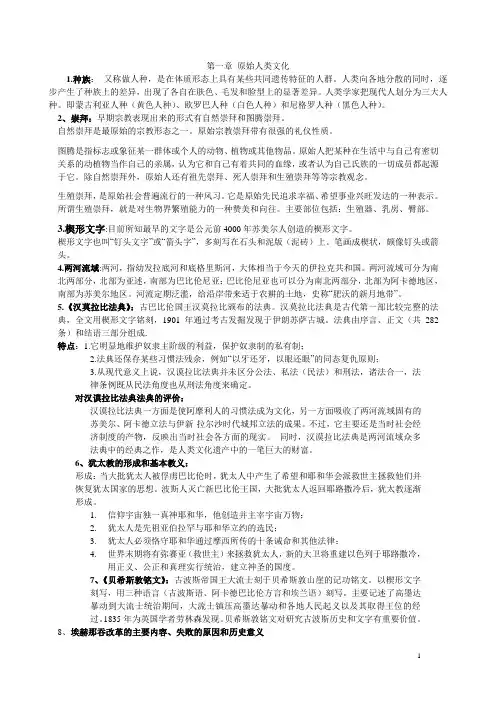
第一章原始人类文化1.种族:又称做人种,是在体质形态上具有某些共同遗传特征的人群。
人类向各地分散的同时,逐步产生了种族上的差异,出现了各自在肤色、毛发和脸型上的显著差异。
人类学家把现代人划分为三大人种。
即蒙古利亚人种(黄色人种)、欧罗巴人种(白色人种)和尼格罗人种(黑色人种)。
2、崇拜:早期宗教表现出来的形式有自然崇拜和图腾崇拜。
自然崇拜是最原始的宗教形态之一。
原始宗教崇拜带有很强的礼仪性质。
图腾是指标志或象征某一群体或个人的动物、植物或其他物品。
原始人把某种在生活中与自己有密切关系的动植物当作自己的亲属,认为它和自己有着共同的血缘,或者认为自己氏族的一切成员都起源于它。
除自然崇拜外,原始人还有祖先崇拜、死人崇拜和生殖崇拜等等宗教观念。
生殖崇拜,是原始社会普遍流行的一种风习。
它是原始先民追求幸福、希望事业兴旺发达的一种表示。
所谓生殖崇拜,就是对生物界繁殖能力的一种赞美和向往。
主要部位包括:生殖器、乳房、臀部。
3.楔形文字:目前所知最早的文字是公元前4000年苏美尔人创造的楔形文字。
楔形文字也叫“钉头文字”或“箭头字”,多刻写在石头和泥版(泥砖)上。
笔画成楔状,颇像钉头或箭头。
4.两河流域:两河,指幼发拉底河和底格里斯河,大体相当于今天的伊拉克共和国。
两河流域可分为南北两部分,北部为亚述,南部为巴比伦尼亚;巴比伦尼亚也可以分为南北两部分,北部为阿卡德地区,南部为苏美尔地区。
河流定期泛滥,给沿岸带来适于农耕的土地,史称“肥沃的新月地带”。
5.《汉莫拉比法典》:古巴比伦国王汉莫拉比颁布的法典。
汉莫拉比法典是古代第一部比较完整的法典,全文用楔形文字铭刻,1901年通过考古发掘发现于伊朗苏萨古城。
法典由序言、正文(共282条)和结语三部分组成.特点:1.它明显地维护奴隶主阶级的利益,保护奴隶制的私有制;2.法典还保存某些习惯法残余,例如“以牙还牙,以眼还眼”的同态复仇原则;3.从现代意义上说,汉谟拉比法典并未区分公法、私法(民法)和刑法,诸法合一,法律条例既从民法角度也从刑法角度来确定。
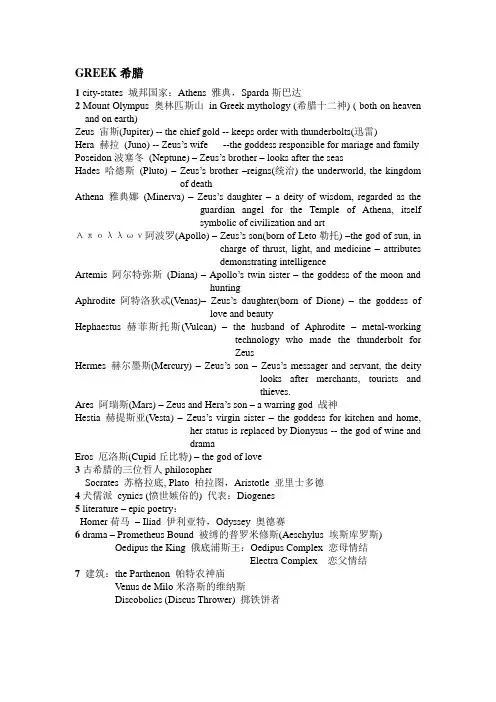
GREEK希腊1 city-states 城邦国家:Athens 雅典,Sparda斯巴达2 Mount Olympus 奥林匹斯山in Greek mythology (希腊十二神) ( both on heaven and on earth)Zeus 宙斯(Jupiter) -- the chief gold -- keeps order with thunderbolts(迅雷)Hera 赫拉(Juno) -- Zeus’s wife --the goddess responsible for mariage and family Poseidon波塞冬(Neptune) – Zeus’s brother – looks after the seasHades 哈德斯(Pluto) – Zeus’s brother –reigns(统治) the underworld, the kingdomof deathAthena 雅典娜(Minerva) –Zeus’s daughter –a deity of wisdom, regarded as theguardian angel for the Temple of Athena, itselfsymbolic of civilization and artΑπολλων阿波罗(Apollo) – Zeus’s son(born of Leto勒托) –the god of sun, incharge of thrust, light, and medicine –attributesdemonstrating intelligenceArtemis 阿尔特弥斯(Diana) – Apollo’s twin sister – the goddess of the moon andhuntingAphrodite 阿特洛狄忒(Venas)–Zeus’s daughter(born of Dione) –the goddess oflove and beautyHephaestus 赫菲斯托斯(Vulcan) –the husband of Aphrodite –metal-workingtechnology who made the thunderbolt forZeusHermes 赫尔墨斯(Mercury) –Zeus’s son –Zeus’s messager and servant, the deitylooks after merchants, tourists andthieves.Ares 阿瑞斯(Mars) – Zeus and Hera’s son – a warring god 战神Hestia 赫提斯亚(Vesta) –Zeus’s virgin sister –the goddess for kitchen and home,her status is replaced by Dionysus -- the god of wine anddramaEros 厄洛斯(Cupid丘比特) – the god of love3古希腊的三位哲人philosopherSocrates 苏格拉底, Plato 柏拉图,Aristotle 亚里士多德4犬儒派cynics (愤世嫉俗的) 代表:Diogenes5 literature – epic poetry:Homer荷马– Iliad 伊利亚特,Odyssey 奥德赛6 drama – Prometheus Bound 被缚的普罗米修斯(Aeschylus 埃斯库罗斯)Oedipus the King 俄底浦斯王:Oedipus Complex 恋母情结Electra Complex 恋父情结7建筑:the Parthenon 帕特农神庙Venus de Milo米洛斯的维纳斯Discobolics (Discus Thrower) 掷铁饼者Rome1. 将领:Julius Caesar(尤利西斯—凯撒)Octavianus(Octavian )屋大维(Octobor), Augustus 奥古斯都(August)He initiated a way of ruling by calling himself the First Citizen, meaning head of state 首脑2 文学:Virgil 维吉尔——Aeneid 埃涅阿斯记(epic poem)3 建筑:colosseum 圆形角斗场Pantheon 万神殿Bible1.Pentateuch 摩西五书Genesis 创世纪– God’s creation of the worldthe Great Flood (Noah’s Ark) 诺亚方舟the Tower of Babel 巴别塔Exodus出埃及记—Ten Commandments 十诫Leviticus 利来记Nambers 民数记Deuteronomy 生命记2.Jewish Festivals 犹太人节日The Sabbath安息日Chanukah or Hanuka灯节Shavuot 五旬节Passover 逾越节3.the Middle Ages 中世纪The period in European history from the collapse of the Roman Civilization in the 5th century AD to the period of the Renaissance in the 14th century is termed generally as the Middle Ages.(1000年)The Renaissance文艺复兴–三杰1 Leonardo da vinci 达芬奇(artist and scientist)The Virgin of the Rocks 岩间圣母Mona Lisa蒙娜丽莎The last Supper 最后的晚餐2 Michelangelo米开朗基罗(Buonarotti)(poet and architect)Genesis 创世纪Final Judgement 最后的审判the sculpture David 雕像大卫3 Raphael 拉斐尔The School of Athens 雅典学院Sistine Madonna 西斯廷圣母1Genesis ; The SabbathGenesis describes God’s creation of the world and traces the history of the Hebrews from Abraham(亚伯拉罕) to Joseph(约瑟).The Sabbath :It begins from the sunset of Friday and lasts to the sunset of Saturday. It was set apart by Moses as a holy day, for rest and worship in commemoration of the completion of the creation.2. Noah’s Ark; the dove, the raven and the rainbowGod saw that the whole world was corrupt and full of violence. So he intended to destroy them, and the earth with them. Noah was a righteous man, the one blameless man of his time; God knew that Noah was trying to do right. He told Noah that heintended to bring the waters of the flood over the earth to destroy the earth and its wicked people. But Noah shall go into the ark with his sons, his wife and his sons’ wives with you. Soon it was time for Noah to go inside with his family and other creatures. After forty days and forty nights the rain stopped. But the water stayed on the earth for many months after that. Then Noah tried to find out if the waters had gone down.Raven1.He sent out a raven, but the raven kept flying to and fro until the waters were dried up.Dove2. Noah sent out a dove to see what would happen. The dove could not find a place to rest so it came back to the ark.3.Seven days later he sent the dove out again. This time she returned with an olive leaf in her beak.4.So he waited another seven days and sent her out once more. This time the dove did not return.the water was finally gone and the earth was dry. Now Noah and his family could leave the ark.Rainbow PromiseFinally, the earth dried up and the Noah’s came back the earth. God promised. ―All flesh shall never again be cut off by the water of the flood, neither shall there be again a flood to destroy the earth.‖Rainbow stands for God’s eternal promise to the human3.The Babel Tower; confusion ;different languages in the worldThe story of the Tower of Babel, from the Book of Genesis, is used to explain why we have so many languages. The essence of the story is that the people of Shinar (Babylonia) decided to build a giant tower that would reach into heaven. It was an enormous enterprise, so it took a long time and lots of cooperation among people who all spoke the same language. After a while, God disrupted the project. To make it impossible for the workers to communicate, he forced everyone to speak a different language4. Exodus ;the meaning of Exodus in the Bi ble and today’s English ;Passover (逾越节)Passover (逾越节);an important Jewish religious holiday when the escape of the Jews from Egypt is rememberedExodus in the Bible:the second book of the Old Testament: tells of the departure of the Israelites(以色列人) out of slavery in Egypt led by Moses; God gave them the Ten Commandments(十诫) and the rest of Mosaic law(摩西律法) on Mount Sinai(西奈山) during the Exodus Exodus in today’s English:a journey by a large group to escape from a hostile environment 大批的离去Canaan-a land flowing with milk and honey, the promised land5.The birth of Jesus ChristOver two thousand years ago a young woman by the name of Mary lived in the small town of Nazareth. Mary was to be married to a carpenter named Joseph. One day an angel Gabriel said that she will have a baby name Jesus. When they arrived in Bethlehem they did not have a place to stay. The kind innkeeper told them he had a stable that they could stay in for the night. Jesus, God’s Son, was born that night. Mary wrapped baby Jesus in a small cloth and placed him in a manger of hay.The shepherds牧羊人That night there were shepherds staying in the fields nearby. Suddenly, an angel before them. He told them that the Son of God has been born today. They will recognize Him by this sign; he will be wrapped snugly in cloth, lying in a manger. The shepherds hurried to go to see Baby Jesus. When they found him in the stable in Bethlehem, They kneeled before the baby and worshipped him.Candy cane拐杖糖A candy manufacturer living in Indiana wanted to produce a kind of candy which can tell others about the existence of God. At the very beginning, white candy. Then,One thick red line: The blood Jesus shed on the cross. Through his death we are forgiven. Three fine red lines: the whipping Jesus suffered. By his stripes we are healed. White candy: innocent Jesus who was born of a virgin. Hard candy: Jesus, the cornerstone of the church, is our rock of refuge. J-shaped candy cane: Jesus Christ and the cane of shepherds.The Three Wise Men from the east东方三博士After Jesus was born,wise men(magi)came to look for Him,from an area which is now in either Iran or Saudi Arabia. They were certainly men of learning. They had seen an unusual new star,and knew that it told of the birth of a special king. They followed it to East - and eventually found the place where Mary,Joseph and Jesus were staying. To bring honor to the child,they brought rich gifts:gold,frankincense and myrrh .The Star of Bethlehem伯利恒的星The Magi, they observed a huge star directly over Bethlehem. A shining star in thesky over Bethlehem and guided Three Wise Men to the small manger where the Christ Child lay.6. The last supperThe Last Supper is a 15th century mural painting in Milan created by Leonardo da Vinci. It represents the scene of The Last Supper from the final days of Jesus as it is told in the when Jesus announces that one of his Twelve Disciples(Bartholomew, James, son of Alphaeus,Andrew,Judas Iscariot, Peter,John,Thomas, James the Greater,Philip,Matthew, Jude ThaddeusSimon the Zealot )would betray him.The Lord’s Supper圣餐the name applies to the memorial of Yeshiva’s death.So the historical origin of the Lord’s Supper is that final supper that Jesus ate with his disciples the night before he was crucified. It is a Christian sacrament commemorating the Last Supper by consecrating bread and wi neBread and wineThe Lord’s Supper is an ordinance of the Lord in which gathered believers eat bread, signifying Christ’s body given for His people, and drink the cup of the Lord, signifying the Ne w Covenant in Christ’s blood. We do this in remembrance of the Lord’ death until He comes. Those who eat and drink in a worthy manner partake of Christ’s body and blood spiritually by faith.The Holy Grail圣杯In Christian mythology, the Holy Grail was the dish, plate, cup or vessel that caught Jesus' blood during his crucifixion. It was said to have the power to heal all wounds.A theme joined to the Christianized Arthurian mythos relates to the quest for the Holy Grail.The death of ChristA prickly crown of thorns was placed on his head and he was stripped naked. He was led to Golgotha where he would be crucified. Stake-like nails were driven through his wrists and ankles, fastening him to the cross where he was crucified between two convicted criminals.the Resurrection复活The resurrection of Jesus is the Christian religious belief that Jesus Christ returned to life on the Sunday following the Friday on which he was executed by crucifixion. On the third day he rose again in accordance with the Scriptures‖.JudasAfter the dinner, Jesus went out as usual to the Mountain of Olives. While he was speaking to his disciples, Judas come out with a crowd, he was leading them. He approached Jesus and kissed him. Because of the Judas' betray, Jesus was arrestedPeterAt the time of Jesus' s arrested, Peter had denied Jesus for three times before the cock crows as Jesus predicts before.The Good FridayGood Friday, also known as Holy Friday, Black Friday, Great Friday, It is a religious holiday observed primarily by Christians commemorating the crucifixion (苦难)of Jesus Christ and his death at Calvary. The holiday is observed during Holy Week(复活节前周) on the Friday preceding Easter Sunday(复活节).EasterEaster is a Christian festival and holiday celebrating the resurrection of Jesus Christ on the third day after his crucifixion at Calvary as described in the New Testament. Easter is preceded by Lent, a forty-day period of fasting, prayer, and penance.7(1)Pygmalion(皮革马利翁), a king of Cyprus(塞浦路斯), was a famous sculptor. He made a beautiful ivory statue of a woman and gave it the name of Galatea(加拉泰亚), and fell in love with it. At his prayers ,Aphrodite—the goddess of beauty and love(爱神阿芙洛狄忒), gave it life. And Galatea ,now a woman in flesh and blood, became Pygmalion' wife. --Greek mythology Pygmalion effect The Pygmalion effect is a form of self-fulfilling prophecy(自我实现), people will internalize(内在化)their negative label, and those with positive labels succeed accordingly. Within sociology(社会学), the effect is often cited with regard to education and social class.The Pygmalion Effect is that people tend to behave as you expect they will.(2)George Bernard Shaw(萧伯纳)Irish dramatist, literary critic, a socialist spokesman, and a leading figure in the 20th century theater, who was regarded as 'a second Shakespeare', who had revolutionized the British theatre. A defender of women's rights, and advocate of equality of income. In 1925 he was awarded the Nobel Prize for Literature.3)Theme of My fair lady: Higgins, a phonetics(语言学家)created a new girl Eliza from lower class to upper class by teaching her English.For others: encourage and praiseFor ourselves:Self-fulfilling and confident8 money is not everythinganyone can not be much too greedy.9The golden fleece 金羊毛:symbol of wealth, spirit of adventure, the pursuit of ideals and happiness.10Pandora’s box 帕朵拉的盒子:curiosity, temptation, hope11 Endimion 恩底弥翁(1) John keats’ (约翰*济慈) poem,based on the Greek myth of Endymion (theshepherd 牧羊人beloved by the moon goddess Selene 塞勒涅)。
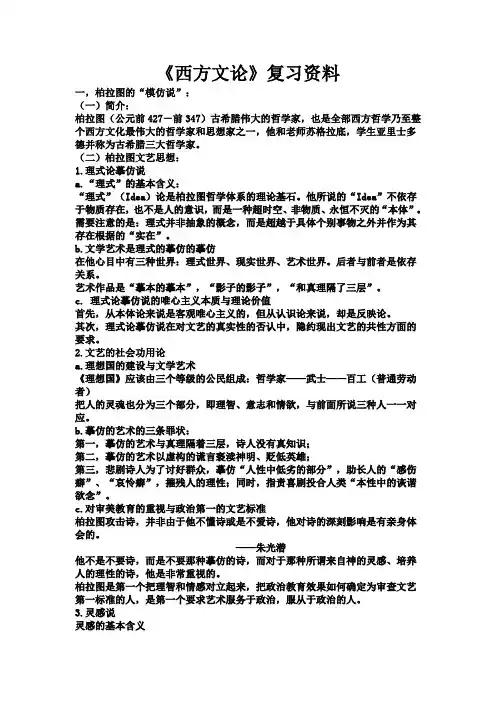
《西方文论》复习资料一,柏拉图的“模仿说”:(一)简介:柏拉图(公元前427-前347)古希腊伟大的哲学家,也是全部西方哲学乃至整个西方文化最伟大的哲学家和思想家之一,他和老师苏格拉底,学生亚里士多德并称为古希腊三大哲学家。
(二)柏拉图文艺思想:1.理式论摹仿说a.“理式”的基本含义:“理式”(I d e a)论是柏拉图哲学体系的理论基石。
他所说的“I d e a”不依存于物质存在,也不是人的意识,而是一种超时空、非物质、永恒不灭的“本体”。
需要注意的是:理式并非抽象的概念,而是超越于具体个别事物之外并作为其存在根据的“实在”。
b.文学艺术是理式的摹仿的摹仿在他心目中有三种世界:理式世界、现实世界、艺术世界。
后者与前者是依存关系。
艺术作品是“摹本的摹本”,“影子的影子”,“和真理隔了三层”。
c.理式论摹仿说的唯心主义本质与理论价值首先,从本体论来说是客观唯心主义的,但从认识论来说,却是反映论。
其次,理式论摹仿说在对文艺的真实性的否认中,隐约现出文艺的共性方面的要求。
2.文艺的社会功用论a.理想国的建设与文学艺术《理想国》应该由三个等级的公民组成:哲学家——武士——百工(普通劳动者)把人的灵魂也分为三个部分,即理智、意志和情欲,与前面所说三种人一一对应。
b.摹仿的艺术的三条罪状:第一,摹仿的艺术与真理隔着三层,诗人没有真知识;第二,摹仿的艺术以虚构的谎言亵渎神明、贬低英雄;第三,悲剧诗人为了讨好群众,摹仿“人性中低劣的部分”,助长人的“感伤癖”、“哀怜癖”,摧残人的理性;同时,指责喜剧投合人类“本性中的诙谐欲念”。
c.对审美教育的重视与政治第一的文艺标准柏拉图攻击诗,并非由于他不懂诗或是不爱诗,他对诗的深刻影响是有亲身体会的。
——朱光潜他不是不要诗,而是不要那种摹仿的诗,而对于那种所谓来自神的灵感、培养人的理性的诗,他是非常重视的。
柏拉图是第一个把理智和情感对立起来,把政治教育效果如何确定为审查文艺第一标准的人,是第一个要求艺术服务于政治,服从于政治的人。
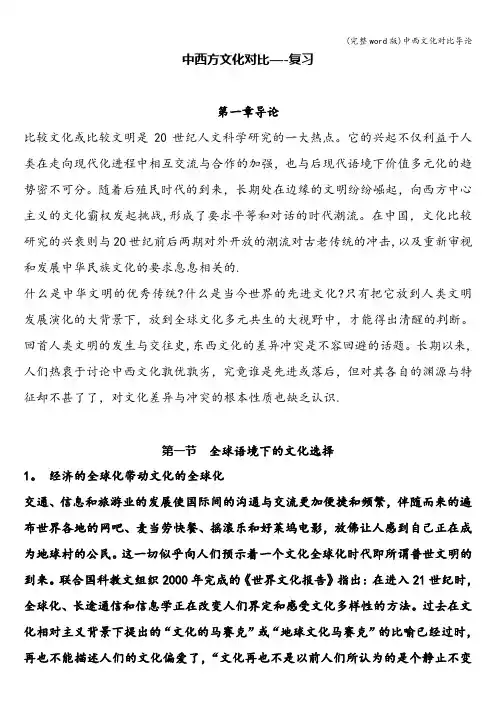
中西方文化对比—-复习第一章导论比较文化或比较文明是20世纪人文科学研究的一大热点。
它的兴起不仅利益于人类在走向现代化进程中相互交流与合作的加强,也与后现代语境下价值多元化的趋势密不可分。
随着后殖民时代的到来,长期处在边缘的文明纷纷崛起,向西方中心主义的文化霸权发起挑战,形成了要求平等和对话的时代潮流。
在中国,文化比较研究的兴衰则与20世纪前后两期对外开放的潮流对古老传统的冲击,以及重新审视和发展中华民族文化的要求息息相关的.什么是中华文明的优秀传统?什么是当今世界的先进文化?只有把它放到人类文明发展演化的大背景下,放到全球文化多元共生的大视野中,才能得出清醒的判断。
回首人类文明的发生与交往史,东西文化的差异冲突是不容回避的话题。
长期以来,人们热衷于讨论中西文化孰优孰劣,究竟谁是先进或落后,但对其各自的渊源与特征却不甚了了,对文化差异与冲突的根本性质也缺乏认识.第一节全球语境下的文化选择1。
经济的全球化带动文化的全球化交通、信息和旅游业的发展使国际间的沟通与交流更加便捷和频繁,伴随而来的遍布世界各地的网吧、麦当劳快餐、摇滚乐和好莱坞电影,放佛让人感到自己正在成为地球村的公民。
这一切似乎向人们预示着一个文化全球化时代即所谓普世文明的到来。
联合国科教文组织2000年完成的《世界文化报告》指出:在进入21世纪时,全球化、长途通信和信息学正在改变人们界定和感受文化多样性的方法。
过去在文化相对主义背景下提出的“文化的马赛克”或“地球文化马赛克”的比喻已经过时,再也不能描述人们的文化偏爱了,“文化再也不是以前人们所认为的是个静止不变的、封闭的、固定的集装箱。
文化实际上变成了通过媒体和国际因特网在全球进行交流的跨越分界的创造.我们现在必须把问文化看作一个过程,而不是一个已经完成的产品。
"西方中心主义观念支配下,一些西方政治家和学者的观点:一个以西方式的自由民主制和自由主义价值观的普及为基础的全球一体化的时代的到来。

西方文化概论(赵林)第一章:古希腊罗马文化第一节:爱琴文明与希腊神话传说一、爱琴文明(克里特与迈锡尼)的发展演化(一)米诺斯(克里特)文明1.出现:2.*发展:3.结论:(二)*迈锡尼文明二、希腊神话与传说(一)希腊神话传说的源流1.形成和代表:2.实质:(二)希腊神谱(谱系分明)(三)★《神谱》的文化学意义(四)★荷马史诗与“系统叙事诗”1.荷马史诗:2.“系统叙事诗”:第二节:希腊城邦文化一、希腊城邦制的发展演变(一)希腊城邦的崛起与殖民1.城邦的发展:2.城邦及城邦与殖民地关系的特点:(二)早期希腊城邦的政治变革1.城邦及城邦政治状况:2.直接民主制:3.君主→僭主→民主:(三)斯巴达的政治文化(四)雅典的政治与文化:(自由精神、宽容气氛)1.直接民主制的实质:2.雅典辉煌的精髓:(五)从分离主义到帝国主义1.早期分离主义的产生原因及破坏:2.希波战争:3.伯罗奔尼撒战争:二、城邦时代的希腊文化(一)希腊的宗教生活1.概况:2.奥林匹斯神话与酒神节的狂欢秘祭:(二)希腊悲剧的“命运”主题1.概况:2.★希腊悲剧与近代悲剧的区别:(三)希腊喜剧的“后现代”意义1.概况:2.★意义:(四)希腊哲学的发生与演化1.起源与概况:2.唯物主义代表及米利都学派的贡献:3.唯心主义:(五)希腊的科学(特点):1.早期的希腊科学很难与哲学相区别:2.希腊的实验科学与当时的艺术有着密切的联系:(六)希腊文化精神1.成就:2.特点:三、城邦文化的衰落与希腊化时代(一)雅典民主制的蜕变(从分离主义到帝国主义):(二)亚历山大帝国与希腊化时代1.亚历山大帝国:2.“希腊化”:3.希腊化的特点和成果:(三)希腊文化精神的凋敝1.总括:2.具体表现:第四节:罗马帝国的兴衰一、罗马帝国的兴衰(一)罗马的起源1.构成:罗马纳人、塔提恩人(萨宾人)、卢克伦人(二)罗马帝国的扩张(共和国和帝国两个阶段)(三)*罗马政治体制的演变1.王政时期:2.罗马共和国:3.罗马帝国:(四)*凯撒与奥古斯都(五)*罗马帝国的衰亡1.罗马的衰亡过程:2.★军队的性质的蜕变:(公民兵制→募兵制→雇佣军)二、★罗马文化的特征(一)希腊人与罗马人(二)*罗马英雄主义的盛衰(三)罗马的宗教1.罗马宗教的概貌:2.罗马宗教的发展演化:3.★希腊宗教与罗马宗教之比较:(四)罗马的哲学、文学艺术和科学1.哲学:2.文学:3.艺术风格:4.科学:(五)罗马法1.发展过程:2.内容:3.法律规范的范围:4.影响:(六)*罗马世风的腐化第二章:中世纪基督教文化第一节:基督教的早期发展一、基督教的“两希”传统(一)律法主义的犹太教1.基督教渊源:2.犹太历史:3.犹太教的“摩西五经”(“律法书”):4.希伯来文化与希腊文化的区别:(二)耶稣与基督教1.产生:2.发展:(三)基督教与犹太教1.基督教跟犹太教的区别:2.犹太教与基督教特点的具体表现:3.派别:(四)基督教与希腊哲学1.奥尔弗斯教2.毕达哥拉斯主义3.柏拉图哲学4.斯多葛主义(五)“基督教的真正父亲”1.表现:2.贡献:二、基督教与罗马帝国(一)*苦难的历程1.时间:2.殉道精神:(二)基督教的合法化与国教化1.“长期和平时期”:2.最后的迫害3.君士坦丁与《米兰敕令》4.负面效果与教义分歧5.国教化(三)*基督教与异教文化(四)修道运动1.产生:2.目的:3.过程:4.结论:三、基督教与日耳曼蛮族(一)*罗马帝国时期的日耳曼人(二)蛮族大入侵与罗马帝国的灭亡1.过程:2.蛮族入侵的原因:3.结果:(三)日耳曼蛮族对基督教的皈依1.蛮族的皈依:2.北非教会的退出:第二节:基督教与西欧封建社会一、*西欧封建社会的经济生活(一)封建制与庄园经济1.封建制:2.豁免权:3.农奴:4.庄园经济:5.结果:(二)修道院经济1.崛起:2.结果:3.发展:4.结论:(三)西欧封建社会的生活状况1.表现:2.原因:二、西欧封建社会的政治格局(一)“十字架”与“宝剑”(教俗之争)1.原因及表现:2.过程:(二)“阿维农之囚”与罗马教会的衰落1.背景:2.“阿维农之囚”:(1305-1377年)3.罗马教会的衰落:4.教会衰落的原因:(三)*十字军东征1.背景:2.十字军东征的实施:3.实质:三、西欧封建社会的文化状况(一)*中世纪西欧社会的精神生活(二)教会与大学1.产生:2.特点:(三)中世纪的哲学1.发展与概貌:2.教父哲学:3.经院哲学:(四)骑士文学、哥特式建筑1.*骑士文学2.哥特式建筑四、中世纪基督教文化的衰落(一)信仰的松懈与道德的沦丧(赎罪方式的改变)(二)教会的堕落(绝对的权力导致绝对的腐败)(三)宗教裁判所1.产生过程:2.迫害对象:(四)★基督教文化的内在矛盾1.基督教文化的本质特点:2.痛苦和矛盾的原因:第三章:西方近现代文化第一节:文化大变革的滥觞一、文艺复兴与人文主义(一)*中世纪文化与近代文化的历史分水岭(二)文艺复兴(意大利)1.“文艺复兴”(Renaissance):2.表现及后果:3.范围:(文学艺术)4.★特点:5.局限:(三)人文主义1.来源和创始:2.理论基础和精神实质:3.发展方向:(四)人文主义与罗马教会1.目的:2.存在理由:(五)*文艺复兴时期的意大利人二、★宗教改革(日耳曼)(一)★改革原因:(二)★马丁·路德的宗教改革(三)英国的宗教改革1.新教及其流派:2.英国宗教改革:3.改革成功的原因:4.内容:5.发展:6.最终形成:(伊丽莎白时代)(四)加尔文的宗教改革1.简介:2.改革措施:3.加尔文派与路德派的区别:4.加尔文派的禁欲主义:4.*再洗礼派:(五)★宗教改革的历史意义1.★定位:2.★成就:3.★意义:(宗教和世俗两方面)4.弊端:(六)共产主义理想的起源1.表现:2.路德与闵采尔的区别:3.影响:第二节:新视域与新背景一、地理大发现及其后果(一)航海活动的时代背景和初始动机1.时代背景:2.航海动机:(二)航海活动的发展过程1.序幕:葡萄牙王子——亨利(西非南部)2.葡萄牙的航海:3.西班牙的航海:4.瓜分世界的最早协议:(三)*海外扩张与殖民主义二、近代民族国家的崛起(一)王朝国家与民族国家1.王朝国家:2.民族国家:3.★民族国家的特点:(二)“★势力均衡”与大国兴衰1.★特点:多元格局2. 15~16世纪的西、法、英3. 17世纪的荷、英、法(三)奥斯曼帝国与俄罗斯帝国1.奥斯曼土耳其:江河日下2.俄罗斯帝国:蒸蒸日上三、★从宗教专制(战争)到宗教宽容(一)★“反宗教改革运动”与宗教战争1.★“反宗教改革运动”——罗马教会自身的改革运动2.宗教战争:(二)★《威斯特伐利亚和约》与宗教宽容1.《威斯特伐利亚和约》定位:2.★《威斯特伐利亚和约》的内容和精神:3.★宗教宽容:第三节:理性时代与启蒙运动一、“天才世纪”的文化成就(一)怀疑主义与经验主义(二)科学理性的勃兴(三)自然神论与古典主义1. 17世纪的信仰状况“2.自然神论及其特点:(四)古典主义(五)人性的觉醒1.原因:2.结果:自然秩序和天赋观念二、现代化转型的完成(一)18世纪法国启蒙运动1.表现:2.结果:(二)基督教信仰与在西方现代文化中的意义(三)西方的政治文化变革(四)*西方经济的发展和国际格局1.*经济状况:2.*国际格局:(五)浪漫主义与现实主义1.浪漫主义:2.批判现实主义:(六)西方现代科技的巨大成就与精神苦恼第一章:古希腊罗马文化第一节:爱琴文明与希腊神话传说一、爱琴文明(克里特与迈锡尼)的发展演化(一)米诺斯(克里特)文明1.出现:前2500年,克里特岛克里特(米诺斯)文明以及后来的迈锡尼文明统称爱琴文明。
西方文论复习资料《西方文论》复资料XXX整理西方文论复资料一、填空(15%)1、美在“数的和谐统一”的思想是由XXX学派提出来的。
2、XXX是西方第一个从研究自然过渡到研究社会、探求美和艺术的本质的哲学家。
3、在XXX的悲剧理论中,居于悲剧六个成分(性格、思想、情节、言词、形象和歌曲)之首的是情节。
4、“灵魂回忆”说是XXX灵感理论的一部分,其意是说灵感的获得过程是灵魂对真善美的理式世界的回忆。
5、《论崇高》这部作品大约完成于公元前一世纪,作者XXX是与XXX同一时代的人。
6、XXX“寓教于乐”理论揭示了文学艺术的审美作用和认识教育作用的关系。
7、“四义说”是XXX提出的关于文学语言的重要理论,它揭示了语言艺术意义的多层次性,这四义分别指的是语言的字面义、譬喻义、道德义和寓言义。
8、17世纪法国新古典主义时期的代表性文论家是的XXX,反映他古典主义实际的主要著作是《诗的艺术》。
9、在XXX对诗与画的界限做分别时认为诗与画有不同的美学原则,画的最高原则是美,诗的最高原则是真。
10、法国启蒙主义文论家中先崇尚XXX后又完全贬低XXX的作家是XXX。
11、在法国古典主义那里,理性即等于自然,等于古典P105。
(不肯定)另一个答案是“道德”12、德国十八世纪卓越的艺术史家XXX提出古希腊艺术的最高理想是“尊贵的纯真”和“静穆的伟大”,此论影响了这一时代许多的诗人、艺术家,包括XXX。
13、XXX的主要美学著作是《审美教育书简》和《朴素的诗和伤感的诗》。
14、作为XXX一切哲学和美学思想的出发点是他的理性万能论。
190(不确定)15、XXX艺术哲学的基本命题是“美是理念的感性显现”。
16、英国文艺复兴时期文论家XXX对诗人给予了极高的评价,他说“世界是铜的,而只有诗人才给予我们金的。
”17、XXX关于悲剧冲突的本质理论认为悲剧冲突起源于“好人犯了错误”。
18、XXX论述文艺的主要著作是《诗学》19、XXX的主要文艺著作是《诗艺》20、XXX的文艺理论著作是《诗的艺术》21、XXX的美学和文艺思想主要在他的《判断力批判》里得到了表述。
10对外1《西方文化与礼仪》复习材料6.16一、课程导论1、“西方”概念(Western world 、the West、the Occident)西方文化中的西方,从地域上讲,主要指欧洲,18世纪以来开始包括北美洲的美国和加拿大。
2、文化(culture)概念辨析文化是指人类创造的一切物质产品和精神产品的总和。
广义的文化(着眼于人类与一般动物,人类社会与自然界的本质区别,其涵盖面非常广)广义文化(culture)又称作“大文化”,大体上包括物质、精神、制度和行为四大部分。
【——物质文化:指人类创造的种种物质文明,如工厂、城市、宫殿、祠庙、长城、桥梁、器皿、工具、服饰、饮食、交通工具、日常用品等,是一种可见的显性文化,属实体文化。
——精神文化:指精神的、人格的、主观的东西,如价值观念、宗教信仰、审美情趣、思维方式、心理活动等,是一种不可见的隐性文化,属虚体文化。
——制度文化:指各种社会规范,它反映出一系列处理人与人相互关系的准则,如政治制度、经济制度、家庭制度、社会制度等。
——行为文化:指人际交往中约定俗成的礼节仪式、生活习惯、民情风俗等,即社会生活中的行为模式。
】狭义的文化指的是意识形态所创造的精神文化,包括宗教、信仰、风俗习惯、道德情操、学术思想、文学艺术、科学技术、各种制度等。
排除人类社会历史生活中关于物质创造活动及其结果的部分,专注于精神创造活动及其结果。
广义的“文化”,包罗万象。
狭义的“文化”,仅关注精神文化,不够全面。
3、西方文化的源与流从内容上讲,其源头主要是由希腊的理性和艺术、希伯来的宗教、罗马的法律组成,其流则是由中世纪文化、文艺复兴、宗教改革、科学革命、启蒙运动、美国独立战争、法国大革命、工业革命、现代哲学思潮、现代主义、后现代主义等共同汇合而成。
二、第一章两河流域文化与埃及文化1、两河流域,史书上通常根据希腊人的称呼冠之为“美索不达米亚”,指的是底格里斯河和幼发拉底河流经的区域。
2015-2016西方文化概论-复习提纲1.What are the major functions of Greek mythology?The first one is explanation. Greek myths lent structure and order to the world and explained how the current state of things had originated. One of the commonest types of explanation given in myths relates to ritual.Myths helped worshipers make sense of a religious practice by telling how the practice originated. A prime exampleis sacrifice, a ritual that involved killing a domesticated animal as an offering to the gods. The second one is exploration. Myths charted paths through difficult territory, examining contradictions and ambiguities. For instance,one of Homer’s Iliads’s themes explores the limits of honor.The dramatic genre of tragedy provides the clearest example of mythical exploration. The third one is legitimation(合法化). A claim, an action, or a relationship acquired extra authority if it had a precedent(先例)in myth. The final one is entertainment. Myth telling was a source of enjoyment and entertainment.,which was seen in Homer’s epics and some performances of tragic dramas.2.“Achilles’ Heel” is an idiom contributed to English language by Homerin his epic of Iliad. What are the meaning and origin of this idiom?It means a weak or vulnerable factor.The legend of Achilles has it that he was dipped into the river Styx by his mother Thetis in order to make him invulnerable. His heel wasn't covered by the water and he was later killed by an arrow wound to his heel.3.Why is Homer regarded as one of the most important figures in Westernhistory?Homer is best known as the author of the Iliad and the Odyssey. He was believed by the ancient Greeks to have been the first and greatest of the epic poets. Author ofthe first known literature of Europe, he is central to the Western canon.Homer wasthe earliest molder of the Greek outlook and character.For centuries, Greek youngsters grew up reciting the Homeric epics and admiring the Homeric heroes,who strove for honor and faced suffering and death with courage.4.In what important ways was Aristotle different from Plato? What aresome of Aristotle’s works that are still influential today?1)Aristotle was different from Plato in theories of ideas,forms,ethical thoughts and politicalthoughts. Aristotle emphasized direct observation of nature and insisted that theoryshould follow fact. This is different from Plato’s reliance on subjective thinking.2)He thought that “idea” and matter together made concrete individual realities in which hediffered from Plato who held that ideas had higher reality than the political world. His significant works includes: Ethics, Politics and Rhetoric.5.Who was Moses? What did he do for the Hebrews?Moses was a famous Hebrew leader. Around 1300 B.C., Moses led the Hebrews to leave Egypt for the Promised Land. This was called the Exodus which lasted forty years. When the wandering Hebrews left the desert and entered the mountainous Sinai, Moses climbed to the top of the mountain to receive form god message, which came to be known as the Ten Commandments. He died shortly before the Hebrews arrived at their homeland.6.What is the chief Roman achievement in architecture? Give someexamples.1)The Romans were great engineers. They covered their world from one end to the other withroads, bridges,aqueducts, theatres and arenas.2)Some examples:A. The Pantheon: the greatest the best preserved Roman temple built in 27B.C..B. Pont du Gard: it is an exceptionally well-preserved aqueduct that spans a wide valley insouthern France.7.What contribution did the Romans make to the laws of manycontinental European countries?Romans made contributions to the development of Roman law in form of Jus Civile, Jus Gentium Corpus and Juris Civilis.The systematic study of Roman law spread from Italy throughout Europe from the 12th century onward. With the revival of European commerce and the inadequacy of medieval lawto meet the requirements of the changing economic and social conditions, Roman law became incorporated in the legal systems of the many continental European countries.8.Why do we say the Bible has shaped Western culture more decisivelythan anything else ever written?Judeo-Christian tradition constitutes one of the two major components of European culture. The Bible which is virtually related to every phase of human life greatly influences people’s daily life, especially in the Middle Ages when almost everyone was a Christian; The Bible has great impact upon western literature. For a long period of time, the Latin Bible was accepted as the authority and Latin was official language of the Roman Catholic Church, so most Europe literature at that time was in Latin. Besides it is generally accepted that the English Bible and Shakespeare are two great reservoirs of Modern English. Furthermore, the use of Biblical themes has been a literary tradition. In fact few great English and American writers of the 17th, 18th,19th and 20th century can be read and appreciated with satisfaction without a sufficient knowledge of the Bible; The study of the Christian teaching especially the Bible has become an important branch of knowledge—scholasticism which has been prevalent for centuries; The Bible has also influenced western philosophies and science. Thus the Bible has shaped western culture more decisively than anything else ever written.9.Why do we say the Bible, especially the Old Testament, has closerelations with the Mesopotamian culture?The Hebrew patriarchs—Abraham (ancestor of multitude), Isaac, and Jacob (Israel), so prominently depicted(描述) in the Old Testament —were chieftains(头领) of semi-nomadic(游牧民族) clans that roamed(流浪) Palestine(巴勒斯坦) and occasionally journeyed to Mesopotamian civilization. For example, there are parallels between biblical law and the Mesopotamian legal tradition. Several biblical stories—the Creation, the Flood, the Garden of Eden—derive from Mesopotamian sources.10.Why is the Middle Ages in Europe often called as “Dark Ages”?The term known as the Middle Ages is synonymous with the Dark Ages for several reasonsas the period between 500-1500 A.D. included political turmoil, social unrest and the spread of disease. The Middle Ages brought great change to Europe in many respects, including social mobility, politics and the way of life. Some changes proved beneficial, but the time period experienced negative effects from the change too11.What contributions did the Crusades(十字军东征军) make to the westerncivilization?Although the Crusades did not achieve their goal to regain the Holy land, they brought the E ast into closer contact with the West. And they greatly influenced the history of Europe.Besides, through their contact with the more cultured Byzantines and Moslems, the western Europeans changed many of their old ideas.The Crusades also resulted in renewing people’s interest in learning and invention.。
1.文化的概念及构成内容概念:,文化是人类社会具有独立特性的综合体系,它主要包括社会生产与生活方式、社会组织形态和精神组织形态三个大的层次。
这三个大的层次是互相关联的。
它也就必然是人类的行为与精神活动的总体。
从本质上说,这是一种文化总体性构成的观念。
文化体系的构成:1、各国与各民族人民的衣、食、住、行等社会生活及其风俗习惯。
2、社会生产类型,指文化类型的主要生产方式,即是工业文化、农业文化、渔猎文化等。
3、国家政治机制,包括国家政体与国体、国家法律制度、政府机构等。
4、语言文字、科学技术等。
5、文化的精神取向,主要是宗教信仰、思想观念、文化逻辑与民族精神、道德评价等。
2.斯巴达城邦与雅典城邦在政治、经济及文化方面的比较斯巴达政治(1)王权统治时期较长,以后则以贵族寡头政治为主,对外实行军事扩张(2)议事会:包括国王在内的30人,主要是贵族掌权,向大会提出建议并宣布休会,是最高权力机构公民大会:全体公民都有权利参加,仅有表决权(3)实行三等级制:公民(斯巴达人)、奴隶(希洛人)、商人(皮里啊西人)(4)实行严格的军事制度,力量强大,基本控制了伯罗奔尼撒半岛经济(1)以农业经济为主,重农抑商,规定斯巴达人不得经商(2)农业经济为主、物产丰富,基本上可以自给自足(3)实行土地与奴隶国有制文化(1)文化落后,在哲学、诗歌、戏剧与艺术领域都没有重要贡献,与同时期是我雅典城邦不可同日而语(2)生活简朴,英勇善战,在战争中从不恐惧,视死如归雅典政治(1)制定法律划分阶层:贵族、农民、手工业者。
只有贵族可以从政,充当官职(2)奴隶与异邦人地位低下(3)维护民主,英勇善战经济(1)雅典一农牧业为主要生产方式,但工商业极为发达,是地中海地区的货物运转中心(2)公民生活简朴,贫富差距不大文化(1)雅典人热爱艺术,在建筑与雕塑方面的建树十分突出(2)社会思想活跃,产生了一大批哲学家与思想家(3)并不意味着雅典人堕落或懦弱,而是勇气惊人3.罗马的建立过程,经历了那些时代及灭亡的直接与更本原因建立:公元前8世纪,希腊人来到亚平宁半岛开拓殖民,建立了大量城邦,统称为“新城”,所以城邦中罗马城邦最为强大,后来发展成为罗马帝国,接续了古希腊文化,与希腊一起成为西方文明的起源。
西方文论期末复习资料(推荐5篇)第一篇:西方文论期末复习资料西方文论一、亚里士多德的悲剧理论:1、悲剧定义:悲剧是对一个严肃、完整、有一定长度的行动的模仿,他用的是语言,具有各种精心雕琢的装饰,个就其位地在剧的各个部分,模仿的样式是戏剧表演,不是一味叙述;通过引起怜悯和恐惧之情,而是这两种感情得到净化。
2、悲剧的四因:质料因、形式因、动力因和目的因。
3、悲剧的六个成分:情节、性格、言词、思想、形象和歌曲。
二、贺拉斯:1、生平:屋大维统治下的著名诗人,写讽刺是和抒情诗;2、古典主义三原则:(1)模仿说(借鉴原则):在秉承亚里士多德的文艺模仿人生急促上提出文艺模仿古典(古希腊典范)的原则,主张向前人学习;A、沿用古典题材(讲古希腊诗篇改为戏剧);B、提倡发现新体裁;(2)合式原则:恰如其分的表现诗中描绘的人物,艺术上的协调一致、恰当、得体,符合自然、情理、观众心理和艺术的原则;具体要求:A、结构上虚实参差,毫无破绽;B、人物性格自相一致,合乎类型,合乎特征;(类型说,定型说)C、要有高贵的内容和优雅的形式:要求文艺必须是高贵的、优雅的,要有阶级内含,是雅俗文化划分的滥觞;(3)理性原则:作家素质论:A、认为作家最重要的素质是判断力,即艺术家正确的思辨能力(如何判断改写什么和怎么写的能力);B、技艺训练的三个方面:a、模仿古希腊作品,将其作为范例;b、要敢于创新c、敢于接受批评,不断修改作品;作家正确判断力的源头:思想、道德、知识。
3、寓教于乐说:教:诗的教化功能乐:娱乐(1)认为诗的教化功能和娱乐作用并举(寓教于乐说的核心);(2)认为诗人给人益处(教化功能)和乐趣(娱乐),将乐看作是教的手段,使其为政治、法律服务。
容易走向极端。
三、朗基努斯《论崇高》:1、《论崇高》:西方文学史上最早谈论“风格论”的著作,“风格”是指“崇高的风格”,认认为崇高的作品能给人以惊叹和狂喜,不容判断而必然接受,感染力是不可抗拒的,使读者陷入迷狂状态,文学上的崇高是指伟大心灵的回声。
1. What do you think of the influence Greek culture has exerted on Western Civilization as a whole? Give examples.Greek culture is the cradle of Western civilization and has an enormous impact on Western culture. (The specific contributions are found in the areas of philosophy, politics, literature, art, science and architecture.)①Greek politics was one of the greatest influences on Western Civilization. The Greeks were the first to successfully create a government based on the consensus of the people and thus provided a foundation for Western democracy.②The second significant influence was that of philosophy. The Socratic idea about ethics and knowledge helped the Westerners care more for the effect of knowledge and value of morality, both of which give sound guidance to people to improve and change the world outside themselves, i.e. human society and the natural world.③Later generations of Westerners have benefited a lot from Greek culture, such as painting, sculpture, drama, (architecture, poetry and historical works). Classicism had Greek culture as one of the crucial sources, which helped Westerners so much that they ascribed the origin of the Renaissance to it. This changed the intellectual conditions of the later medieval period and opened the way to the modern era in the West.2. What are the major features and achievements of the Renaissance? Give examples.The Renaissance is characterized by seeking ideological emancipation, intellectual freedom and political awareness, based on cultural production and religious reformation. All these were undertaken or unfolded gradually but widely, extending its influences to every corner of Europe, with more and more people getting involved.The achievements were seen principally in six areas, namely, painting, sculpture, poetry, fiction, drama and religious reformation. Instances can be found in these areas , such as the huge change of subjects and styles in painting. The medieval painting used to center on depicting Jesus Christ and other Christian subjects, not only effecting similar and limited subjects but also depicting typical facial expressions and manners. The great artists in the Renaissance started to focus on the images with individualistic temperament, highlighting humanity instead of divinity, thus breaking away from stereotyped medieval models.3. Say something about the features and contributions of utilitarianism, utopian socialism and classical economics.Utilitarianism is the idea that the moral worth of an action is determined by its contribution to overall utility, That is, its contribution to the calculation of pleasure and gain one can have as a result of that action. The calculation is not just material, but spiritual or moral. Utilitarianism provides the motivation and condition for an action of any kind, either individual or collective, and offers the principle for making laws to ensure justice and equality required of a society.Utopian socialism refers to the beliefs held by early socialists, who created hypothetical visions of perfect egalitarian and communalist societies without practical consideration of actual conditions of the capitalist society they lived in and thus could not carry out their ideals due to the powerful hindrance. However some of the Utopianideals, such as those about women's equality and emancipation, were reasonable and consequently absorbed by Marxism.Classical economist is widely regarded as the beginning of modern economic thoughts. It is the idea that a free market can regulate itself. Its founders include Adam Smith, David Ricardo, Thomas Malthus and John Stuart Mill. Adam Smith’s The Wealth of Nations in 1776 is considered to mark the beginning of classical economics.4. Give a general survey of the intellectual and ideological developments in Europe by focusing on one or two theoretical schools in the following list: positivism, pragmatism, intuitionalism, psychoanalysis, existentialism, logical atomism, logical positivism and naturalist philosophy.Existentialism is an important school of thought in the modern age. It is a term that has been used in the work of 19th and 20th century philosophers among whom are Soren Aabye Kierkegaard, Karl Jaspers, Martin Heidegger and Jean-Paul Sartre. Despite the doctrinal differences and disagreements among them, they all take the human subject and the condition of existence as a starting point for philosophical exploration.Existential philosophy begins with a sense of confusion in the face of an absurd world. Many existentialists regard traditional philosophy, in both style and content, as too abstract and remote from concrete human experiences. Existentialism has exerted its influence upon Western literature in terms of providing the philosophical basis for the emergence of the “theatre of the absurd” in the field of play.5. Try to recall how Chinese popular culture came into fashion in the last 2 or 3 decades with the introduction of western pop music and art.Chinese popular culture came into fashion in the early 1980s along with China's opening up to the outside world. There emerged many popular singers among whom are Deng Lijun, Mao Amin, etc. Cui Jian deserves credit for his contribution to C hina’s rock music, being the first musician of the genre. Now Chinese popular music has entered a period of prosperous development in which old and new musicians compete for excellence and the audience is large in number. Popular music has become a profitable industry.As for art, both in painting and sculpture, Chinese artists have been influenced by the Western postmodernist ideas, but they are still at the early stage of learning and imitation. More and more artists begin to voice their concerns for environment, globalization, morality and many other social problems brought about by the rapid economy development.6. 人文研究的价值(无标准答案)Since Renaissance, Humanistic Studies have gradually spread in Western countries, which helps people emancipate from the religious principles. Thus, people have a good chance to know themselves and the world better. Humanism lays the ideological basis for the modern science and leads talents to explore the nature and create more inventions. It’s a process of research from god to human, from culture to science that contributes to the firm belief that the value of human is the most important.Andreas Vesalius: dissection of human bodiesBaruch Spinoza: pan-theological philosopherCleisthenes: carry out legislative reformCopernicus: heliocentrismDa Vinci: The Last SupperDaniel Defoe: Robinson CrusoeDante: The Divine ComedyDraco: punish trivial crimes with the death sentenceEmile Zola: Rougon-MacquartExpressionism: Eugene O’NeillFrancois Rabelais: GargantuaFuturism: MarinettiGaius Julius Caesar: The Civil WarGalileo: invention of the pendulum clockGeoffrey Chaucer: Canterbury TalesGoncourt brothers: Germinie LacerteuxGuy de Maupassant: The NecklaceHenry Fielding: Tom JonesImagism: Ezra PoundIsaac Israeli: follower of Neo-platonismIssac Singer: the Nobel Prize winner for literature in 1978Jack London: The Sea-WolfJohn Bunyan: Pilgrim’s ProgressJohn Milton: Paradise LostJonathan Swift: Gulliver’s TravelsLivy: History of RomeMichel Montaigne: EssaisMiguel de Cervantes: Don QuixoteNewton: establishment of the modern study of opticsOvid: Appollo and DaphnePaphael Sanzio: The School of AthensPeisistratus: advocate peasants’ welfare and popular entertainments Pericles: supreme council check the behavior of leadersShmuel Agnon: the Nobel Prize winner for literature in 1966 Sholem Aleyshem: the Mark Twain of JewsSolon: abolish slave laborSymbolism: BaudelaireTerence: The Mother-in-LawTheodore Dreiser: An American TragedyVirgil: The AeneidWilliam Harvey: systemic circulationWilliam Shakespeare: A Mid-summer Night’s DreamAsceticism: A theory or practice which advocates spiritual improvement by living a particularly hard life, as is seen in the experiences of some religious practice.Jacob’s Ladder: A Biblical term suggesting a ladder to heaven which appeared in the Book of Genesis. When the Biblical patriarch Jacob fled from his brother Esau, he imagined the ladder to heaven.Lost generation: A term first used by Gertrude Stein to describe the post-World War I generation of American writers, men and women haunted by a sense of betrayal and emptiness brought about by the destructiveness of the war. The term is commonly applied to Hart Crane, Ernst Hemingway, F.Scott Fitzgerald and others.Mount Olympus is a high mountain in Greece, well-known for the “home of the gods”in Greek mythology. The deities who are said to dwell on this mountain are ruled by Zeus, including his wife, his brothers, his sisters and his children. Performance art: A term usually used to refer to a kind of advent-garde or conceptual art which grew out of the visual arts and began to be identified in the 1960s .Performance art is unconventional and often challenges the audience to think in new and unconventional ways.Pulitzer: Joseph Pulitzer was a famous Hungarian-born American journalist and newspaper publisher. He ran newspapers in St. Louis and New York City, and established and endowed the Pulitzer Prizes.The Apollonian style and the Dionysian style:The two terms by Nietzsche initiated in his The Birth of Tragedy, which refers separately to the cheerful and optimistic style and the gloomy and passionate style.。